Sword's 1/72 Curtiss
SB2C-4 Helldiver | | History For those of you wondering why the Curtiss-Wright Company stopped making aircraft, The Curtiss Helldiver provides an excellent example of why they failed. Granted, all the Helldiver’s problems did not originate within the Curtiss organization, but the almost overwhelming succession of circumstances, poor design, factory moves, and the general rush of a new war all combined to push the Helldiver into production and fleet service. The SB2C history can be traced, with obvious visual similarities to the Curtiss SBC biplane, also named Helldiver. The biplane Helldiver was the last biplane to join the fleet. Curtiss submitted the SB2C design in response to a 1938 Navy design competition for a new scout bomber to operate from carriers of the future. One of the requirements, and perhaps the one that doomed the SB2C to live a troubled life, was that two of them must be able to fit on a carrier elevator. Curtiss’ design was a very tubby, short fuselage, with a huge tail to offset the poor aerodynamics of the design. This instability would plague the Helldiver throughout its life. Wind tunnel testing indicated that the new airplane had too high a stall speed, so the wing was increased in size and leading edge slats incorporated. First flight occurred on 18 Dec. 1940. Within two months, in Feb. 1941 the engine quit on final approach and the prototype crashed. While it was not totally destroyed, the flight-testing was delayed until May. Seven months later the wing failed during a dive test. More delays! The first production Helldiver finally rolled of the Columbus line and flew in June, 1942, a full three years after the initial contract was awarded. And that airplane was destroyed when the wing failed during a dive in January, 1943. 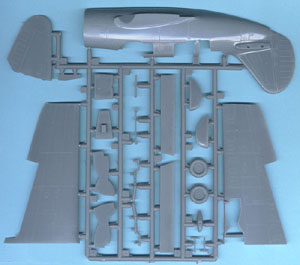 Even with the long delays, the airplane was not ready for fleet service. The post-production modifications to install self sealing fuel tanks, radar, and armor plating not only further delayed delivery, but they added considerable weight to an already badly overweight airplane. This rather poor performance would plague the Helldiver for the rest of its service life. Even with the long delays, the airplane was not ready for fleet service. The post-production modifications to install self sealing fuel tanks, radar, and armor plating not only further delayed delivery, but they added considerable weight to an already badly overweight airplane. This rather poor performance would plague the Helldiver for the rest of its service life.
The Kit Initial impressions of the kit are somewhat mixed. Packaging is the usual plastic bag segmented into three different compartments. Decals and vacuum-formed canopies (2) in one section, the resin parts and a few injected parts in another, and the two main trees in the third. A good process as the delicate decals, canopies and resin bits are protected. The injection-molded parts on the two main trees have the usual small amounts of flash where the upper and lower molds meet. This is not difficult to clean up, but leaves me with a somewhat negative first impression of quality. I am trying to learn to not let this poor first impression of these types of kits influence me too much. The quality is there; it just takes a couple swipes with the hobby knife, or sandpaper to find. 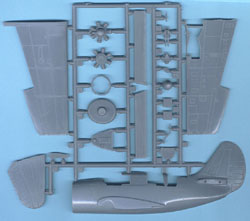 The “ribbing” for the fabric tail surfaces are fine raised lines and the rest of the kit is scribed lines. These are finely done and sharp edged. The panel details on the underside of the wings are especially well done. As is now normal with the most of the Czech Republic kits, there are no locator pins anywhere. The good part of that is no recesses or sink marks where the pins, holes are. The bad news is you have more work getting things to line up accurately. The “ribbing” for the fabric tail surfaces are fine raised lines and the rest of the kit is scribed lines. These are finely done and sharp edged. The panel details on the underside of the wings are especially well done. As is now normal with the most of the Czech Republic kits, there are no locator pins anywhere. The good part of that is no recesses or sink marks where the pins, holes are. The bad news is you have more work getting things to line up accurately.
When I think about modeling the Helldiver, two things come to mind. A huge greenhouse with lots of room to detail an interior and that modelers playground of a rear gunner’s area. The other is the neat dive brakes. So how did they do in these two areas? Well, probably not very well. The pilot’s area has two resin side walls, and resin or plastic bulkheads, seats, and some details. The instrument panel is one of the injection molded parts and while it might be made to work, is over-simplified. 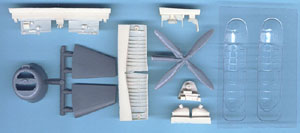 The main event area should be that huge rear gunner’s area and here Sword just kind of ignored it all. The highlight effort is the resin radios/radar that sits on a shelf forward of the gunner. The rest of it is very simplified resin or plastic. The turret ring and twin .30 guns are recognizable, but simple and there is no other significant detail provided. The area that "makes” the Helldiver is the turtle decking aft of the gunner. The accordion fold sides just cry to be opened up and detailed. Nope -not today! No provision to do that at all. I am sure it can be done, but I’ll bet at least one of the two vacuum formed canopies will die in the process. The main event area should be that huge rear gunner’s area and here Sword just kind of ignored it all. The highlight effort is the resin radios/radar that sits on a shelf forward of the gunner. The rest of it is very simplified resin or plastic. The turret ring and twin .30 guns are recognizable, but simple and there is no other significant detail provided. The area that "makes” the Helldiver is the turtle decking aft of the gunner. The accordion fold sides just cry to be opened up and detailed. Nope -not today! No provision to do that at all. I am sure it can be done, but I’ll bet at least one of the two vacuum formed canopies will die in the process.
So how did they do on those neat dive brakes? They are separate injection molded parts, with a top and bottom components, and they do have the teeth in a comb appearance on the upper sections trailing edge, but the injection process was not kind to this detail and clean up will be difficult. The extensive hole pattern that makes the dive brakes so unique is simply scribed circles in the top/bottom of each part. The pattern is much too complex and small to consider drilling out all those holes to correct the impression. 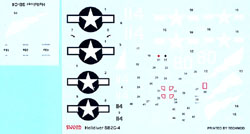 Ok, that takes care of the downside. The good side is the thing is far and away the best 1/7dinky scale Helldiver around. With some work it could be built into the post war –5 version, and the Army’s A-25 is coming, so no need to try to backdate it to the earlier versions. Ok, that takes care of the downside. The good side is the thing is far and away the best 1/7dinky scale Helldiver around. With some work it could be built into the post war –5 version, and the Army’s A-25 is coming, so no need to try to backdate it to the earlier versions.
I think with a little care and work this one will finally put an acceptable finished SB2C-4 on your shelf, and with a lot of work or help from some enterprising brass dealer, it could be made into a real show piece. And if ever a kit needed the brass treatment this one does. Perhaps Eduard or Airways or somebody will skip the planned set for one of the Tamiya or Hasegawa or Accurate Miniature kits that really don’t need it and go for a winner with this one that does. Conclusions Finally a “decent” Beast! Not one of the major players in the second great hate, but significant nevertheless. With the Navy flying it both during and after the war, and Italy and France flying it post war, a good Helldiver has been needed for a long while. As indicated, this one really needs help from the brass troops, but overall a good kit. | 


 



  
    |
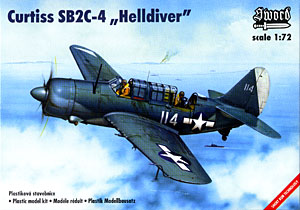
 Even with the long delays, the airplane was not ready for fleet service. The post-production modifications to install self sealing fuel tanks, radar, and armor plating not only further delayed delivery, but they added considerable weight to an already badly overweight airplane. This rather poor performance would plague the Helldiver for the rest of its service life.
Even with the long delays, the airplane was not ready for fleet service. The post-production modifications to install self sealing fuel tanks, radar, and armor plating not only further delayed delivery, but they added considerable weight to an already badly overweight airplane. This rather poor performance would plague the Helldiver for the rest of its service life.  The “ribbing” for the fabric tail surfaces are fine raised lines and the rest of the kit is scribed lines. These are finely done and sharp edged. The panel details on the underside of the wings are especially well done. As is now normal with the most of the Czech Republic kits, there are no locator pins anywhere. The good part of that is no recesses or sink marks where the pins, holes are. The bad news is you have more work getting things to line up accurately.
The “ribbing” for the fabric tail surfaces are fine raised lines and the rest of the kit is scribed lines. These are finely done and sharp edged. The panel details on the underside of the wings are especially well done. As is now normal with the most of the Czech Republic kits, there are no locator pins anywhere. The good part of that is no recesses or sink marks where the pins, holes are. The bad news is you have more work getting things to line up accurately. The main event area should be that huge rear gunner’s area and here Sword just kind of ignored it all. The highlight effort is the resin radios/radar that sits on a shelf forward of the gunner. The rest of it is very simplified resin or plastic. The turret ring and twin .30 guns are recognizable, but simple and there is no other significant detail provided. The area that "makes” the Helldiver is the turtle decking aft of the gunner. The accordion fold sides just cry to be opened up and detailed. Nope -not today! No provision to do that at all. I am sure it can be done, but I’ll bet at least one of the two vacuum formed canopies will die in the process.
The main event area should be that huge rear gunner’s area and here Sword just kind of ignored it all. The highlight effort is the resin radios/radar that sits on a shelf forward of the gunner. The rest of it is very simplified resin or plastic. The turret ring and twin .30 guns are recognizable, but simple and there is no other significant detail provided. The area that "makes” the Helldiver is the turtle decking aft of the gunner. The accordion fold sides just cry to be opened up and detailed. Nope -not today! No provision to do that at all. I am sure it can be done, but I’ll bet at least one of the two vacuum formed canopies will die in the process. Ok, that takes care of the downside. The good side is the thing is far and away the best 1/7dinky scale Helldiver around. With some work it could be built into the post war –5 version, and the Army’s A-25 is coming, so no need to try to backdate it to the earlier versions.
Ok, that takes care of the downside. The good side is the thing is far and away the best 1/7dinky scale Helldiver around. With some work it could be built into the post war –5 version, and the Army’s A-25 is coming, so no need to try to backdate it to the earlier versions. 






